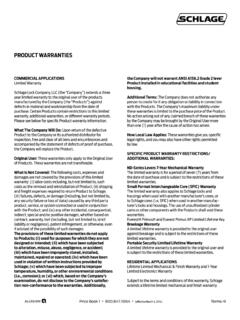Transcription of General Aviation Passenger SAFETY Briefing
1 8 FAA Aviation NewsYou may find this item, orsomething similar to it, onthe pre-start checklist forjust about any small or pis-ton General Aviation (GA) aircraft youfly. You are probably familiar with thepassenger briefings you hear on airlin-ers, and you know that the regula-tions Title 14 of the Code of FederalRegulations (14 CFR) re-quire you to brief your passengers onhow to fasten and unfasten seat beltsand (if installed) SAFETY s clearly important, but have youever stopped to think about what elsea truly complete Passenger briefingin a GA aircraft should include? If not,you might start by taking a look at 14 CFR , which outlines the brief-ing requirements for large and turbine-powered multiengine airplanes andfractional ownership programs.
2 Whilenot everything on this list applies to atypical GA airplane, it still contains allthe basic elements for a comprehen-sive and professional for easy recall, here are theitems essential to a complete passen-ger SAFETY is the item explicitly requiredin the regulations, so it is a good placeto start your Passenger Briefing . Theregulations give the pilot in command(PIC) two specific tasks with regard toseat belts and shoulder first is a duty to briefpassengerson how the seat belts work. You can-not legally take off unless:..the pilot in command ofthat aircraft ensures that eachperson on board is briefed onhow to fasten and unfastenthat person s seat belt and, ifinstalled, shoulder harness.
3 (14 CFR (a)(1)).The second statutory requirementis a duty to notifypassengers that seatbelts must be fastened. Specifically,the rule states that no pilot may takeoff, land, or cause (an aircraft) to bemoved on the surface unless:..the pilot in command ofthat aircraft ensures that eachperson on board has beennotified to fasten his or hersafety belt and, if installed, hisor her shoulder harness. (14 CFR (a)(2).)In addition to these required top-ics, it is a good idea to brief your pas-sengers on how to adjust and lock theseat position. This discussion is espe-cially important for the Passenger inthe right front seat. Just imagine howstartling (not to mention dangerous) itwould be for everyone aboard if anunbriefed and unsecured passengerreacted to sudden rearward seat travelby instinctively grabbing the want your passengers to becomfortable during the flight, so thesecond major item to include in yourbriefing is environmental your passengers where the airvents are located, and tell them howto open and close overhead and/orfloor-level vents in their seating GA airplanes have other envi- ronmental controls ( , cabin heat)
4 General Aviation Passenger SAFETY Briefingstory and photos by Susan ParsonPassenger Briefing Completelocated somewhere on the instrumentpanel. If your Passenger is airplane-savvy, you might show him or her howto adjust some or all of these , though, that for most non-pilots, the instrument panel for eventhe smallest GA aircraft is a bewilder-ing array of dials and knobs andswitches that all look alike. Unlessyour Passenger has at least some ex-perience in GA aircraft, it may be bestto tell them to let you know if they aretoo hot or too cold, so that you canmake the subject of air brings up a moredelicate issue airsickness. Opinionsdiffer widely on whether, and how, todiscuss this topic with pilots advocate a direct ap-proach, including a full Briefing on loca-tion and use of airsickness bags.
5 Oth-ers believe that a specific briefingtriggers the power of suggestion in po-tentially queasy passengers, and preferto avoid the subject entirely. You bethe judge of your passengers tenden-cies toward motion sickness, but if youare in the don t tell group, you will stillwant passengers to know that theyshould tell you right away if they feeluncomfortable for any ExtinguisherFires can, and do, occur in GA air-planes, especially with engine obviously don t want to scareyour passengers, but the extra pair ofhands could be very useful if you findyourself fighting flames during any partof the flight. If you have a fire extin-guisher on board you do, right?
6 Show your passengers where it is lo-cated, how to unlatch it from itsmount, and how to use it in the un-likely event of a , Emergencies, andEquipmentPassenger briefings on airliners al-ways include information on the loca-tion and operation of doors, and yoursmust do no less. The location of thedoor or doors, depending on themodel is no mystery on most GA air-planes, so your Briefing can be limitedto door operation. Make sure thatyour passengers know how to openthe door(s) in the event of an emer-gency evacuation. Since no oneneeds the distraction and discomfortof a door opening in flight, it is also im-portant to brief your passengers onproperly securing the door(s).
7 If your aircraft has doors on bothsides of the fuselage, it is a good ideato develop and brief specific exit pro-cedures to facilitate rapid evacuation ofthe aircraft. For example, you mightplan on keeping your seat forward toallow rear seat passengers to exit viathe left door, while you follow the right-seat Passenger out the starboard method allows you, as PIC andcaptain of your ship, to oversee thepassenger evacuation before leavingthe aircraft yourself. For aircraft with asingle right-side door, consider whatworks best for a given group of pas-sengers. You might want to have theright seat Passenger exit and move theseat to allow rear seat passengers tofollow, with you departing last.
8 Alter-natively, you might want to follow theright-seat Passenger but remain at thedoor to assist in the evacuation ofthose in the rear seats. There is nosingle correct evacuation strategy, sothe most important thing is to think itthrough in advance and communicatethe plan to your part of the emergencyexit Briefing is to designate a gatheringpoint ( , walk aft to avoid the propand gather at the rear of the aircraft).If you carry survival equipment, point itout to all passengers. Stress that safeand expeditious evacuation is themost important consideration, butconsider designating one of your rear-seat passengers to be in charge ofcarrying survival equipment out of theaircraft if circumstances , be sure to explain anyequipment, such as supplementaloxygen, that passengers are expectedto use during the flight.
9 TTraffic and TalkingEven if you are operating under in-strument flight rules (IFR), you still havea responsibility to see and avoid other9 JANUARY/FEBRUARY 2007traffic any time you are in visual mete-orological conditions (VMC). It neverhurts to have extra eyes scanning fortraffic, so brief your passengers to letyou know whenever they spot otheraircraft. In addition, tell them what youwant them to tell you. A simple air-plane on the right will suffice, butsince everyone can visualize a clock,you might ask them to given you trafficinformation in terms of the o clock positions used by ATC. The addedadvantage of this option is that pas-sengers listening to ATC communica-tions will have a better idea of where tolook when you get a traffic for communications talking are another good topic toinclude in your Passenger may not readily under-stand the term sterile cockpit, butthey will certainly understand thatthere are times when you need tofocus fully on your flying.
10 Let yourpassengers know that they should notattempt to talk to you (except for traf-fic point-outs) during the busy take-off/climb and approach/landingphases of the flight. If your intercomdoes not permit you to isolate thecrew, let passengers know if you ex-pect them to minimize their own con-versation during these times. YYour Questions?It is both professional and polite toconclude by giving your passengersan opportunity to ask questions aboutany part of the flight. Since somepassengers may be intimidated by thenovelty of GA flying or embarrassed toask dumb questions, watch for anysigns of confusion or concern. Makea special effort to invite those ques-tions needed to clarify any part of thebriefing they did not understand.













